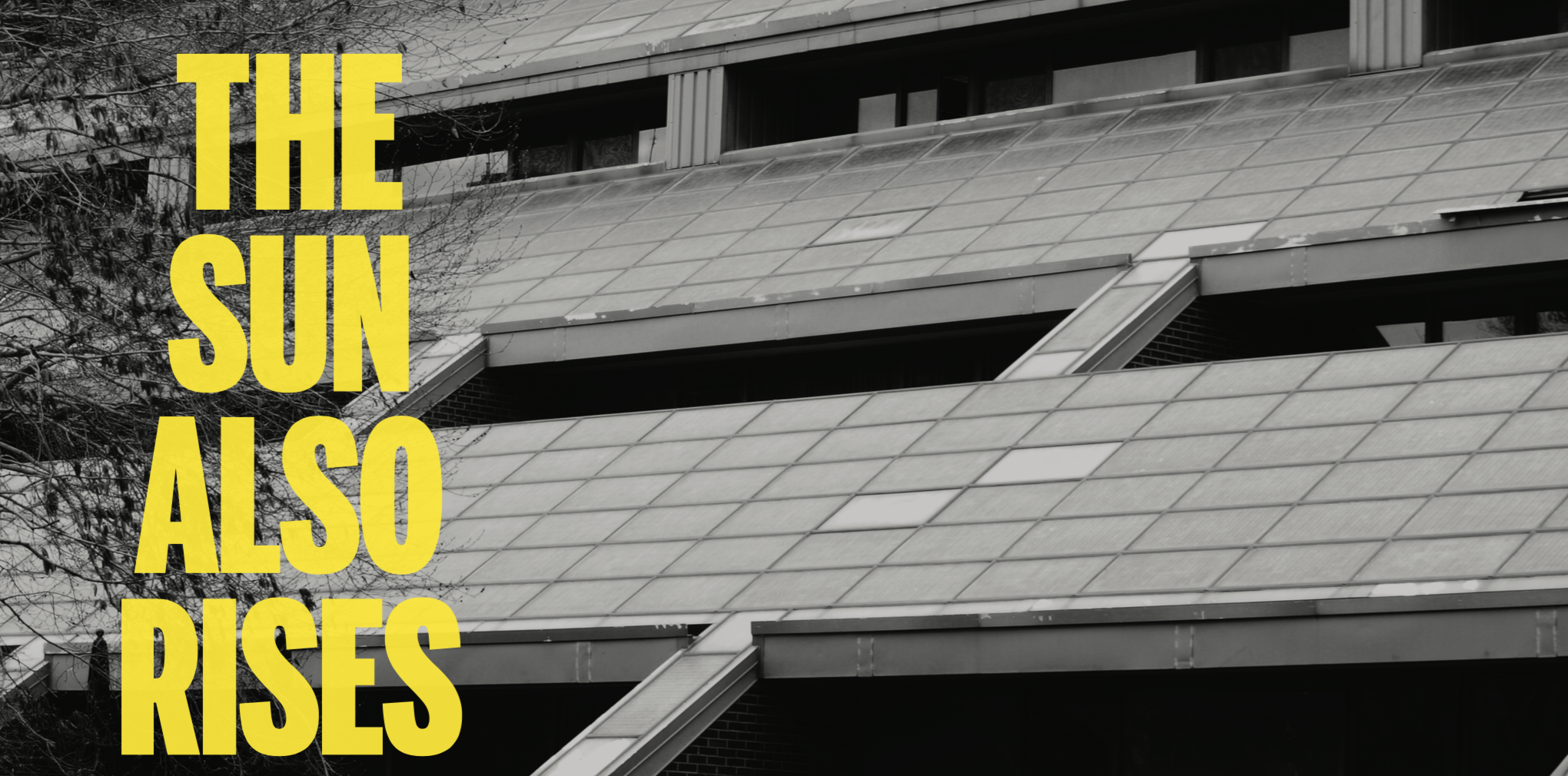Georgetown is currently facing backlash from environmentalists over a proposed off-campus solar project in La Plata, Maryland, which would require clearcutting over 200 acres of forest to make room for solar panels. The La Plata installation is not the university’s first foray into solar energy. Despite the issues with its most recent initiative, Georgetown has a long history with solar power and was at one point on the field’s cutting edge. Solar panels have continued to be a feature of campus to this day.
The university powered up the largest rooftop solar array in the world on the roof of the Intercultural Center (ICC) in 1984. The 4,464 solar panels could produce 300 kilowatts of electricity and operated for almost 30 years. A Washington Post report from January 1979—three years before the ICC itself was completed—said that project was a part of the university’s ongoing efforts to become energy self-sufficient. This effort also included the construction of Yates Field House, which they hoped would have lower heating and cooling costs because much of the structure is underground.
The report projected that half of the funds for the project would come from the U.S. Department of Energy (DOE). Solar power was all the rage in the wake of the 1973 oil crisis, and President Jimmy Carter had just installed solar panels on the roof of the White House. The DOE had many suitors vying for money for solar projects.
Another Washington Post article from May 1979 headlined “GU Solar Project Favored for $8 Million Spot in DOE’s Sun,” detailed just how hard the university was working to secure government funding for the project. Bennett Miller, then-head of the DOE office that evaluated solar proposals, told the Post, “Georgetown is talking to anyone who will listen, here and on the Hill. Hill staffers have called us to say GU is interested in being approved.” An assistant to the House Appropriations Committee said in the same piece that the university had been sending witnesses to committee hearings for two or three years.
Georgetown officially applied for a DOE grant on Jan. 17, 1980, to construct a “Higher Education Exemplar Photovoltaic Facility.” The project was meant to demonstrate how solar technologies, such as photovoltaic materials, could be used in place of regular building materials. For the ICC, the solar panels would be integrated into the roof, where they would need to be weather tight like a normal roof.
The university won the $4 million grant in August 1980 to undertake the project. They sought bids for construction beginning in December 1981, months before the completion of the ICC in 1982. Four contractors responded, but none of the sample panels they provided met the standards needed to survive changes in temperature, humidity, and precipitation. After all four resubmitted their proposals, Georgetown signed a contract with Hughes Aircraft Corporation on March 8, 1983. The project was completed in August 1984 at a total cost of $5.89 million.
The final report on the installation, prepared for the DOE by Georgetown in 1991, outlines the history of the project. The early days of the array were plagued by occasional outages, and on Dec. 9, 1985, there was an accident that shut down the installation for 10 months: Georgetown’s solar consultant had experimented with cleaning the modules and burned out a breaker and a number of components. The university elected to shut down the entire array to avoid a potentially dangerous repeat of the incident and resumed operation only after the issue was satisfactorily dealt with.
An unusual feature of the panels is their rough surface, which reduces the glare of reflected sunlight so as not to affect planes taking off and landing at Reagan National Airport. However, this roughness reduced the panels’ efficiency and also meant that rain did not naturally clean the array. This lead to significant decreases in the panels’ energy production over time. In a test conducted between 1985 and 1988, the New Mexico Solar Energy Institute found a 29 percent loss in energy production over the years. The researchers attributed two-thirds of that loss to the dirtiness of the panels, but later discussions with DOE representatives concluded that cleaning the array would not have been cost-effective. As of the 1991 report, the installation had “never been thoroughly cleaned.”
Overtime, the array became more unproductive. According to Georgetown’s report, in 1991 the system produced 273,835 kilowatt-hours of energy. In 2015, the Voice reported that from July 2009 to June 2010, the panels had produced only 164,300 kilowatt-hours of electricity.
Eventually, the university shut down the array. “Solar panels typically function for about 20 years. These panels lasted nearly a decade beyond this expectation and were disconnected in approximately 2012 after surpassing their operational lifetime,” university spokesperson Matt Hill wrote in an email to the Voice.
With the ICC array offline, the university looked for other sources to replace that energy production. On April 21, 2017, Georgetown announced that it would not only be replacing the ICC solar system but would also install new panels on Regents Hall, Davis Performing Arts Center, Alumni Square, McDonough Gymnasium, and Leo O’Donovan Dining Hall. The university signed a power purchase agreement with Community Renewable Energy (CRE), a solar energy firm.
The project, projected to produce 1.5 million kilowatt-hours of electricity, would be installed at no cost to the university, said Xavier Rivera, then-director of the university’s Department of Energy and Utilities. Georgetown would commit to purchasing the energy at a fixed rate while CRE would retain ownership of the panels and be responsible for their maintenance. CRE would also receive the renewable energy credits from the project.
Robin Morey, then-vice president for Planning and Facilities Management, wrote in an email to the Georgetown community that the project would be economically beneficial for the university. “This is a win-win for both the University and our local communities, driven by our Catholic and Jesuit heritage and commitment the common good,” Morey wrote. “The project allows us to leverage the economics of solar to address critical deferred maintenance needs on campus while advancing our sustainability and common good mission.”
Part of this “common good” would be the revenue produced from the project, a portion of which would go toward creating an investment fund to support clean energy projects in low-income areas across the District.
But the project was never started. When asked why, Hill responded that the university will continue working toward its sustainability goals. “Georgetown is committed to reducing our greenhouse gas emissions by 50 percent by 2020 through a multi-pronged approach to sustainability,” he wrote. “University officials are continuing to meet, assess this project, and determine the best path forward to advance our sustainability goals.”
Georgetown announced the off-campus solar project in La Plata, Maryland, as a facet of these sustainability goals in September 2017.
Nareg Kuyumjian (SFS ’21), president of the Georgetown Renewable Energy and Environmental Network (GREEN), understands why the university is pushing for the off-campus project as opposed to on-campus solar construction. “On-campus solar is less cost-effective, so I guess they’re looking at other ways of conserving energy and cutting down on costs,” Kuyumjian said.
Beyond the expense of on-campus solar are the types of ecological pitfalls that concern La Plata residents. Victoria Boatwright (COL ’22), GREEN’s energy team leader, thinks that on-campus projects are much easier to green-light because they do not face the same potential for negative environmental impacts. “It’s the least ethically difficult because [the roofs are] already black and covered, so it’s the easiest to just say, ‘oh, why don’t we put it on top of that,’” Boatwright said.
The Maryland Department of the Environment is currently reviewing the La Plata proposal to determine whether to allow the system to be built. If completed, the installation would produce enough energy to satisfy half of the university’s electricity needs.
Community members and students have protested the destruction of the area’s forest. However, they say there are other concerns beyond just the loss of trees. The region is recognized by the Audubon Society as an “Important Bird Area” and has two streams with high water quality grades from the state. Some are concerned that the project will create runoff issues which would degrade other valuable waterways further downstream. Members of the local Piscataway Tribe have also come forward and stated that cutting down the forest in their ancestral lands would destroy their history and culture.
The university and its partner in the installation, Origis Energy, have said that an environmental review of the project showed no harmful impacts on the streams, while the loss of trees would be outweighed by the reduction in carbon output. These responses, however, have not seemed to satisfy citizen and student concern.
While there are issues with the replacement of the ICC array and installation of solar panels on other campus buildings, as well as with the off-campus proposal, the university has had some recent success with solar power. In April 2013, the university completed an installation of solar panels on six Magis Row townhouses on 37th Street.
That project, called Solar Street, was a collaboration between the administration and a student group, Georgetown Energy, which worked to promote renewable energy on and off campus. Across the six roofs there is a combined 18 kilowatts of capacity, capable of providing 27 percent of the electricity needs of those townhouses.
The project was feasible because of GUSA’s 2011 reform of the student activities fee, making $3.4 million available for student-proposed projects. Georgetown Energy applied for some of those funds and won $250,000, enough money to install solar panels on 43 townhouses. The group eventually settled on six at a cost of $45,000, limited by the age and construction of some of the townhouse roofs. The remainder of the money was used to create a fund for future student-driven sustainability projects.
The project drew the attention of the Obama Administration. Gary Guzy, then deputy director and general counsel for the White House Council on Environmental Quality, attended the completion ceremony in 2013.
Students in Georgetown Energy entirely led the project, Morey said in a press release. “We just kind of shepherded them through the process of doing the design, construction contracts and getting approval through proper university and city channels,” Morey said. “I think the students see what it actually takes to get the work done.”
Kuyumjian, Boatwright, and the rest of GREEN will be trying to follow a similar path as Georgetown Energy to work with the administration to make Georgetown more energy-efficient and independent. They have submitted a number of proposals for money from the Laudato Si’ Fund, a new university initiative announced on Jan. 29 that makes $300,000 available to members of the Georgetown community for sustainability projects. These proposals include funding for composting projects, bee hives, and making sustainability education a focus of New Student Orientation.
On the energy consumption front, GREEN is working to increase energy conservation around campus by running a “Switch- it-off” challenge, encouraging students to use less energy through simple measures like turning off lights that are not in use, and then comparing the energy-saving results for each building. There used to be a university-run challenge every year by the Office of Sustainability, but the last one was held in the fall of 2017.
Boatwright hopes that students can become more conscious of their energy use and that the university can upgrade its buildings to become more efficient.
“There is no way for us to generate, on campus, enough energy ever to make up for everything that we consume,” Boatwright said. “But I think that you can get closer to it through reductions.”
Solar panels alone will not solve all of Georgetown’s sustainability issues. Staying on track to meet its own environmental targets while keeping up with the ambitious goals for carbon reduction of its peer institutions will require the university to pair its history of innovative solar projects with a future of other creative solutions.
Editor’s Note: An earlier version of this story incorrectly named Xavier Rivera as the director of the university’s Department of Energy and Utilities. He is the former director.





